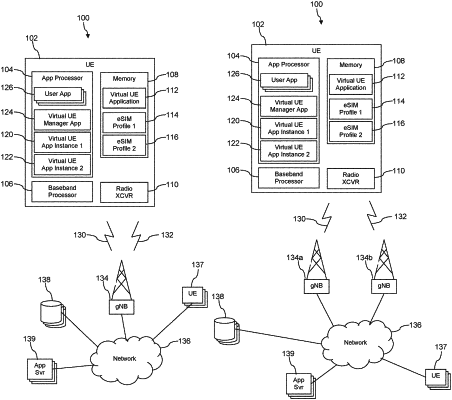| CPC H04W 76/15 (2018.02) [G06F 9/541 (2013.01); H04W 8/18 (2013.01); H04W 12/72 (2021.01)] | 20 Claims |

|
1. A wireless communication device for establishing two different user equipment (UE) radio access network (RAN) attachments concurrently, comprising:
a radio transceiver;
a plurality of antennas including a first antenna and a second antenna;
a baseband processor communicatively coupled to the radio transceiver providing a software interface to support a plurality of virtual user equipment (UE) application instances concurrently;
an application processor communicatively coupled to the baseband processor;
a non-transitory memory;
a virtual UE application stored in the non-transitory memory that, when executed by the application processor as a first virtual UE application instance, the first virtual UE application instance:
accesses a first eSIM profile stored in the non-transitory memory,
establishes a first UE attachment to a radio access network via a first wireless link and the software interface of the baseband processor based on credentials accessed from the first eSIM profile, wherein the first wireless link is supported by the first antenna, and
conducts a first wireless communication session via the first UE attachment,
and when executed by the application processor as a second virtual UE application instance concurrent with the first virtual UE application instance, the second virtual UE application instance:
accesses a second eSIM profile stored in the non-transitory memory,
establishes a second UE attachment to a radio access network via a second wireless link and the software interface of the baseband processor based on credentials accessed from the second eSIM profile, wherein the second wireless link is supported by the second antenna, and
conducts a second wireless communication session via the second UE attachment at the same time the first virtual UE application instance conducts the first wireless communication session.
|